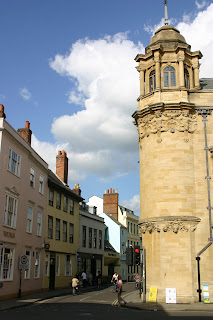Today is the first day of class for our students. Dr. McDougall is teaching a three week version of “D301: The International Business Environment.” The course examines cultural, political, economic, systemic, legal-regulatory, trade, and financial environments and how they affect the international business activities of firms in the United States and in selected other countries. Because we are offering the course abroad for the first time, we will of course be focusing on the United Kingdom. According to Dr. McDougall, “The location of the course at the Oxford University provides a unique opportunity to observe the diversity and complexity of the international environment. While the emphasis of the course is on analysis, the course will also acquaint students with many of the special terms, concepts, and institutions encountered in international business.”
Some people have asked me why we teach this particular course. It is an introductory course on International Business and is one of the required courses for our International Business major. For those students not pursuing a major in International business, the course can be used to help fulfill our International Dimension degree requirement. All Kelley students need six credit hours to meet this requirement, although there are several ways it can be done – including study abroad programs or study of a foreign language at an advanced level. I’m not sure how many of the students here are pursuing the International business major.

Today began with an awesome breakfast buffet. We're looking forward to a repeat of that every day.
Class began with some introductory exercises and an overview of Globalization, International Business, and Global start-ups. After lunch in the dining hall, we were visited by an Oxford Don,
Kenneth Addison, who gave us a quick and broad overview of Oxford's history including geologic, climate, cultural, and political influences.
I learned that "Oxford" comes from "Oxen ford," because in this valley the River Thames (known locally as the Isis) braids into multiple small branches, making it easy to cross. Obviously there is an extremely long history. Over time, the area became a center of learning. Based on monastic societies, the college system eventually developed and became Oxford University. (I can't really do justice to the lecture in a blog!) The Colleges are independent organizations endowed by various royalty and benefactors. More than 500 years ago there were 10; 16 were endowed between the 16th and 19th centuries, and 13 have been founded since 1950. Five women's colleges were founded between 1879 and 1893, but the women were not recognized as students until 1878. They were able to earn degrees after 1920, but not until the 1970s did any of the colleges become co-educational. Currently there are about 12,000 undergraduate students (commoners, exhibitioners, or scholars) and 4000 graduate students, making the University much smaller than IU-Bloomington.

Following Dr. Addison's presentation, we experienced a lively lecture by Kelly Newman, a Shakespearean scholar. She taught us about Shakespeare's problem comedies, and specifically about "The Winter's Tale" - one of four tragic comedies, which we will see before we leave. I think her overview will really help us to understand this play. I've also purchased an annotated copy, which I'm reading now.
After class, some students completed their assigned reading. Many of them are now out exploring Oxford.
 Today was the last day of D301. Most students are leaving tomorrow morning. Some of them are going directly back to the U.S., while others are taking the opportunity to travel more through Europe.
Today was the last day of D301. Most students are leaving tomorrow morning. Some of them are going directly back to the U.S., while others are taking the opportunity to travel more through Europe.





























